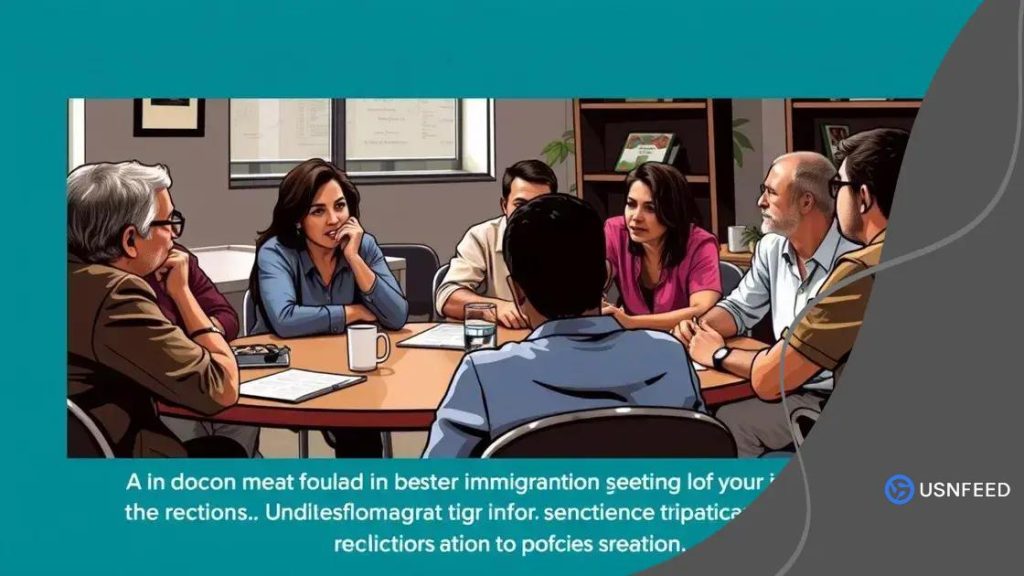Immigration policy discussions: understanding key changes

Community responses to immigration issues include advocacy groups supporting immigrant rights, public forums encouraging dialogue, and initiatives fostering inclusivity, all of which help shape positive immigration policies and promote understanding.
Immigration policy discussions have gained significant attention in recent years, shaping the lives of countless individuals and communities. Have you considered how these discussions affect your daily life and rights? Let’s dive into the key aspects.
Current trends in immigration policies
The landscape of immigration policies is ever-changing, influenced by social, economic, and political factors. Understanding these current trends is essential for anyone impacted by immigration.
Recent Changes
In recent years, various countries have re-evaluated their immigration laws to respond to global challenges. For example, many nations are now prioritizing skilled workers over family reunification. This shift highlights a growing emphasis on economic contributions.
Key Trends to Watch
- Increased border security measures
- Expansion of work visa programs
- Changes in asylum seeker processes
- Focus on immigrant integration programs
Additionally, public opinion plays a significant role in shaping these policies. Polls show that many citizens support stricter immigration controls, often leading governments to adopt tougher stances. This dynamic creates tension and debates within communities about the balance between national security and humanitarian responsibilities.
Impact on Communities
The current trends in immigration policies can profoundly impact local communities. For instance, areas experiencing high immigration often see economic boosts through diverse labor forces. However, they may also face challenges related to resources and integration.
Furthermore, changes in immigration laws can lead to uncertainty for families. Navigating legal requirements can be daunting, particularly for those seeking refuge or better opportunities.
Understanding these shifts in immigration policies not only assists individuals in making informed decisions but also encourages community discussions that foster inclusivity and cooperation.
Impact of recent policy changes
The impact of recent policy changes on immigration is significant and varied. Many people face new challenges and opportunities as governments adapt their laws.
Changes in Work Eligibility
Recent policies have altered who can work and under what conditions. For instance, many countries are now focusing on qualifications and skills rather than family ties. This shift aims to attract skilled labor to fill gaps in the job market.
Challenges for Asylum Seekers
- Longer processing times for claims
- Stricter requirements for documentation
- Increased difficulties in finding legal assistance
- More obstacles to family reunification
Furthermore, these changes can lead to increased anxiety among those seeking safety. Asylum seekers may struggle to navigate complex systems that appear daunting and unfriendly. The public perception of immigration also plays a role, as media coverage can influence how these individuals are treated in their new communities.
Economic Implications
On the economic front, recent immigration policy changes can also impact local economies. Businesses may benefit from a larger pool of skilled workers, enhancing productivity and innovation. However, communities may also experience tension as they adapt to shifting demographics. Some residents might worry about job security and resource availability.
It’s essential to address these concerns with informed discussions and community support. Conversations focused on the benefits of diversity can help smooth transitions and build understanding.
Key stakeholders in immigration discussions

The key stakeholders in immigration discussions play a vital role in shaping policies that affect many lives. Understanding who these stakeholders are helps us grasp how decisions are made.
Government Officials
Public representatives, including lawmakers and local government officials, influence immigration legislation. They often weigh public opinion and their constituents’ needs while crafting policies. Their decisions can lead to changes that either enhance or restrict access to immigration.
Community Organizations
- Non-profits advocating for immigrant rights
- Legal aid organizations providing assistance
- Grassroots movements sharing immigrant stories
- Religious institutions supporting immigrant families
Community organizations are essential in voicing the concerns of immigrants. They strive to ensure that the rights of individuals are protected and that voices are heard. These groups often provide legal resources and support systems for those navigating the complexities of immigration.
Businesses
Businesses also play a significant role in immigration discussions. Many depend on a diverse workforce to fill essential jobs. Employers often advocate for policies that facilitate easier access to work visas, stressing the need for skilled labor in various industries. Their economic contributions can prompt policymakers to consider more inclusive immigration reforms.
Moreover, academic institutions are part of this dialogue. Universities attract international students, which contributes to the economy and strengthens cultural ties. The voices of these institutions are crucial, especially in debates around student visas and residency for graduates.
In summary, the interplay between various stakeholders shapes immigration policies. By understanding these groups and their interests, we can engage in more informed discussions about the future of immigration.
Future predictions for immigration laws
Future predictions for immigration laws suggest ongoing changes that will continue to shape the landscape of how countries approach immigration. These predictions are based on current trends and emerging global issues.
Increased Global Mobility
As the world becomes more connected, we may see countries tailor their laws to encourage global mobility. Nations may create programs to attract talent and skilled workers from abroad. This could involve streamlined visa processes and incentives for immigrants who can fill critical job gaps.
Focus on Humanitarian Needs
- More comprehensive pathways for refugees
- Stronger protections for vulnerable populations
- Collaborations with international organizations
- Expanded community support initiatives
The need for humanitarian responses is also likely to dictate future law changes. Countries may increase their commitments to accepting refugees and asylum seekers, responding to global crises like war and climate change. Stronger partnerships with NGOs and community organizations will be key in supporting these initiatives.
Integration and Inclusivity Measures
Future immigration policies may emphasize integration. Governments might introduce programs to help immigrants settle, find jobs, and adapt to their new communities. Policies that focus on inclusivity can help build stronger societies by ensuring everyone contributes and feels valued.
Moreover, immigration laws will likely become increasingly influenced by public opinion. As communities adapt and change, the ongoing dialogue about immigration can lead to reforms that reflect diverse views and needs.
Finally, technology may play a larger role in processing immigration applications. Innovative systems could improve efficiency and reduce backlogs, allowing for timely responses to visa applications and refugee status determinations.
Community responses to immigration issues
Community responses to immigration issues can play a crucial role in shaping public opinion and influencing policy. These responses often reflect the values and beliefs of local residents while considering the needs of immigrants.
Local Advocacy Groups
Many communities have established local advocacy groups to support immigrants. These organizations work to raise awareness about their rights and provide necessary resources. Advocates often organize events to educate the public on immigration topics, fostering understanding and support.
Building Inclusive Communities
- Language and job training programs
- Cultural exchange events
- Community integration initiatives
- Support for legal assistance
Some communities focus on creating inclusive environments for immigrants. This can involve offering language and job training programs that help newcomers adapt. By hosting cultural exchange events, communities allow immigrants to share their traditions, promoting mutual understanding.
Additionally, many neighborhoods provide support for legal assistance. This ensures that immigrants understand their rights and can navigate the complexities of the immigration system. These resources not only help individuals but foster a stronger, more cohesive community.
Public Forums and Discussions
Public forums provide a platform for residents to voice their concerns and ideas about immigration. In these meetings, locals can discuss their perspectives, hear stories from immigrants, and engage in meaningful dialogue. Such discussions can be eye-opening and encourage collaboration between immigrant populations and long-time residents.
These community responses help to build resilience and understanding, illustrating that immigration is a shared issue that affects everyone. By working together, communities can create solutions that address the challenges of immigration while celebrating diversity.
In summary, addressing immigration issues requires a community-driven approach. By engaging local advocacy groups and creating inclusive environments, communities can support immigrants and foster understanding. Public forums help facilitate important discussions and express diverse viewpoints. These collective efforts not only enhance the immigrant experience but enrich the community as a whole. Celebrating diversity and collaboration can lead to positive changes in immigration laws and policies. Together, we can build a stronger society that values every individual, regardless of their background.
FAQ – Frequently Asked Questions about Immigration Issues
What role do community advocacy groups play in immigration?
Community advocacy groups support immigrants by raising awareness about their rights and providing resources to help them navigate the immigration process.
How can local communities create a welcoming environment for immigrants?
Local communities can create a welcoming environment by offering language and job training programs, hosting cultural exchange events, and providing legal assistance.
Why are public forums important for immigration discussions?
Public forums provide a platform for residents to voice their concerns, share experiences, and engage in meaningful dialogue about immigration issues.
What impact do community responses have on immigration policies?
Community responses can influence immigration policies by demonstrating the public’s support for inclusive measures and highlighting the benefits of diversity.